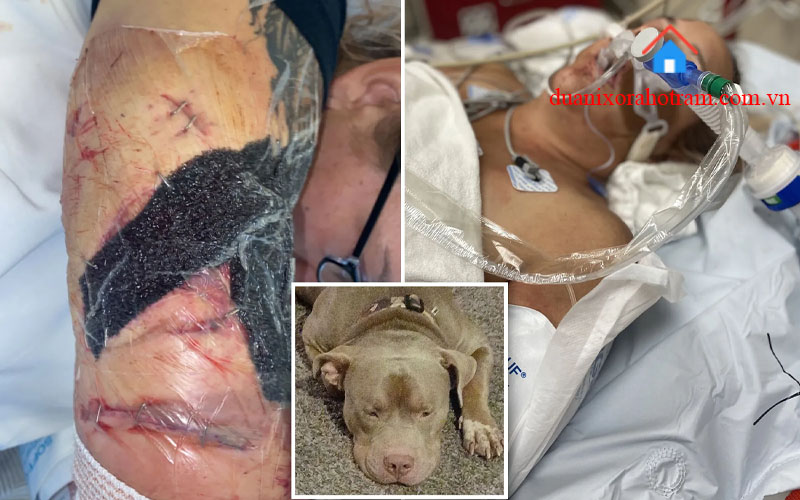The Pitbull Video Gore: Shocking Truth Revealed
Are you a fan of thrilling videos that captivate your senses? Look no further than ‘The Pitbull Video Gore,’ a heart-pounding exploration into the intense world of enthralling footage, available at duanixorahotram.com.vn. Prepare yourself to be on the edge of your seat as you witness bone-chilling encounters and exhilarating action that will leave you begging for more. Brace yourself for a one-of-a-kind visual experience unlike anything you’ve ever seen before.
Contents
Opening statement
In this modern era of technology and the internet, video content has become an integral part of our daily lives. Whether it’s for entertainment, education, or communication, videos have the power to engage and captivate audiences like never before. One particular video that has gained significant attention is the pitbull video gore.
Brief background information
The pitbull video gore has created quite a stir and sparked numerous debates and discussions across various platforms. It features explicit and violent content involving pitbulls, leaving viewers both horrified and intrigued. The graphic nature of the video has raised concerns about animal cruelty, public safety, and the responsibility of media platforms in regulating such content.
The pitbull video gore is a prime example of the dark side of the internet, where shocking and disturbing videos can easily find their way into the public domain. Its existence raises questions about the ease with which violent content can be accessed and distributed online, often with minimal restrictions or consequences.
This video has prompted a broader conversation about the ethical implications of sharing and consuming violent content. While some argue that exposing such videos can raise awareness and lead to change, others are concerned about the desensitization and normalization of violence that can occur as a result.
It is important to emphasize the need for responsible media practices and the implementation of stricter content moderation policies. Platforms that host and distribute videos have a crucial role in ensuring that violent and explicit content like the pitbull video gore is not readily available to unsuspecting viewers, especially children who may stumble upon it.
The debate surrounding the pitbull video gore also highlights the importance of digital literacy and the need for individuals to develop critical thinking skills when consuming online content. It serves as a reminder that not everything on the internet is accurate, safe, or suitable for all audiences.
In conclusion, the pitbull video gore serves as a chilling reminder of the potential dangers that lurk in the digital realm. It raises important questions about the responsibilities of both content creators and platforms in ensuring the safety and well-being of their users. As we navigate this ever-evolving digital landscape, it is crucial to prioritize the ethical use of technology and foster a culture of respect and responsibility online.
The Pitbull Video Gore: An Analysis
The Pitbull Video Gore is a shocking footage that has gained significant attention and generated numerous controversies. This video showcases vicious attacks committed by pitbull dogs, leading to severe injuries and sometimes even deaths. It serves as a grim reminder of the potential danger these animals can pose if not properly trained and handled.
What is the Pitbull Video Gore?
The Pitbull Video Gore is a compilation of graphic and disturbing scenes captured on camera, depicting horrifying incidents involving pitbull dogs. These videos often show aggressive behavior from these animals, including violent attacks on humans, other animals, or even their own kind. The intention behind the video is to raise awareness about the potential harm pitbulls can cause if in the wrong hands and to emphasize the importance of responsible dog ownership.
One of the most alarming aspects of the Pitbull Video Gore is the sheer brutality of the attacks depicted. Viewers are exposed to the harrowing reality of physical injuries suffered by victims, oftentimes resulting in severe trauma or even death. This footage leaves an indelible mark on the viewer’s psyche, forcing them to confront the grim consequences of mishandling or mistreating these powerful dogs.
Controversies surrounding the video
The Pitbull Video Gore has sparked intense controversies and debates within communities worldwide. One of the primary controversies revolves around the ethical implications of sharing such graphic content online. Critics argue that by disseminating this footage, it perpetuates a negative stereotype against pitbulls and breeds fear and prejudice towards them. They claim that these videos contribute to the already existing bias against pitbulls, unfairly painting them as inherently dangerous and violent animals.
However, proponents of the video argue that it serves as a necessary wake-up call for individuals who underestimate the potential danger associated with pitbulls. They believe that by showcasing the reality of these attacks, it encourages a more responsible approach to dog ownership and prompts stricter regulations regarding the breeding and handling of pitbulls.
The controversy surrounding the Pitbull Video Gore also extends to discussions about breed-specific legislation (BSL). BSL is a set of laws that regulate or ban certain breeds based on their perceived danger. Supporters of BSL often use videos like this as evidence to strengthen their argument for stricter regulations on pitbull ownership. Conversely, opponents argue that these videos are sensationalized and fail to consider the numerous well-behaved and loving pitbulls that exist.
In conclusion, the Pitbull Video Gore has become a focal point for discussions around pitbulls and responsible dog ownership. While the footage is undoubtedly distressing, it serves as a reminder of the potential risks involved in owning and mishandling these dogs. It is crucial to approach the subject with a balanced perspective, considering both the specific instances of aggression and the larger context of responsible ownership. Only through education and responsible practices can we mitigate the risks associated with owning any breed of dog, including pitbulls. So, let us use the pitbull video gore as an opportunity for learning, growth, and a greater understanding of responsible pet ownership.
The Impact of the Pitbull Video Gore
Psychological effects on viewers
The pitbull video gore has had a significant impact on the psychological well-being of viewers. The graphic and violent nature of the videos can lead to a range of reactions and emotions. For some individuals, watching these videos can trigger feelings of fear, anxiety, and even trauma. Witnessing such brutality can be deeply distressing and may result in long-lasting psychological effects.
One of the primary psychological effects of the pitbull video gore is the desensitization to violence. Over time, repeated exposure to violent images can lead to a numbing effect, where individuals become less affected by such content. This desensitization can have detrimental consequences, as it may lower individual empathy levels and increase acceptance of violence in society.
Another psychological impact is the development of post-traumatic stress disorder (PTSD) symptoms. People who are especially sensitive or vulnerable may experience intrusive thoughts, nightmares, and flashbacks related to the pitbull video gore. These symptoms can significantly disrupt daily life and may require professional intervention and treatment.
Furthermore, the pitbull video gore can also influence viewers’ attitudes and behaviors towards animals. Research has shown that exposure to violent content can lead to increased aggression and a lack of empathy towards animals. This can have severe consequences for animal welfare, as individuals may imitate the violent acts they witness in the videos or become indifferent to animal suffering.
It is important to recognize the potential harm that the pitbull video gore can inflict on viewers’ mental health. Video platforms and social media websites should take responsibility for monitoring and regulating the dissemination of such violent content. Implementing stricter guidelines and enforcing stronger restrictions can help protect individuals from the negative psychological effects associated with these videos.
Social and cultural implications
The pitbull video gore not only affects individuals on a psychological level but also has significant social and cultural implications. The dissemination of violent content can contribute to the normalization of violence in society, leading to detrimental consequences.
One of the social implications is the desensitization of society towards violence. When graphic content becomes readily available and widely shared, it becomes easier for individuals to become desensitized, blurring the line between entertainment and real-life violence. The pitbull video gore can shape societal norms by influencing what is considered acceptable or entertaining.
Another cultural implication is the impact on moral values and ethical standards. The exposure to violent content can desensitize individuals and erode empathy, compassion, and moral judgment. In a society where violence is increasingly glorified and normalized, the pitbull video gore can contribute to the erosion of these fundamental values.
Additionally, the pitbull video gore can also perpetuate stereotypes and reinforce negative perceptions of certain groups or communities. For example, if these videos predominantly feature a specific demographic engaging in violence, it can lead to biased assumptions and prejudice towards that particular group.
To mitigate the social and cultural implications of the pitbull video gore, it is crucial for society to actively promote media literacy and ethical engagement online. Educating individuals about the potential harms of violent content and fostering critical thinking skills can help individuals make informed choices when consuming media.
Furthermore, collaborations between online platforms, law enforcement, and mental health professionals can facilitate the identification and intervention for individuals at risk of negative psychological effects. These collaborations can establish guidelines for content creators and users, ensuring responsible and ethical content sharing practices.
In conclusion, the impact of the pitbull video gore extends beyond individual psychological effects. It influences societal norms, ethical standards, and perceptions. Recognizing the potential harm and taking proactive measures to regulate and educate can help mitigate the negative consequences associated with these videos. By acknowledging the psychological and social implications, we can work towards creating a safer and more empathetic online environment for all users.
The Ethics and Legalities Involved
Ethical considerations of creating and sharing violent content
In today’s digital age, where information spreads rapidly and easily, the creation and sharing of violent content has become a subject of ethical debate. The ease with which graphic videos, such as the infamous “the pitbull video gore,” can be captured and disseminated has raised concerns about the potential harm they may cause to individuals and society as a whole.
One of the primary ethical considerations surrounding the creation and sharing of violent content is the potential for psychological harm to those who view it. Graphic videos that depict violence, whether it is towards humans or animals, can have a profound impact on the mental well-being of individuals. Exposure to such content can lead to feelings of fear, distress, and even trauma, especially for vulnerable individuals such as children or those with pre-existing mental health conditions. This raises questions about the responsibility of content creators and sharers in ensuring the well-being of their audience.
Another ethical concern is the desensitization that may occur as a result of frequent exposure to violent content. Research has shown that repeated exposure to violent media can lead to reduced sensitivity and empathy towards others’ suffering. This desensitization can have far-reaching consequences, affecting individuals’ behavior and attitudes towards violence in the real world. Thus, there is a need to carefully consider the potential impact of sharing graphic videos and the responsibility that content creators and sharers bear in shaping societal norms.
The privacy and consent of individuals depicted in violent content are also important ethical considerations. In many cases, the victims of violence featured in graphic videos may not have given their consent for their images to be circulated on the internet. Sharing such content without consent violates individuals’ privacy rights and can cause significant distress to those involved and their families. It is crucial to question whether the public interest in exposing violence outweighs the potential harm caused to the individuals directly affected.
Furthermore, the ethical implications of sharing violent content extend beyond its immediate impact on individuals. The circulation of graphic videos can perpetuate a culture of violence and reinforce harmful stereotypes. For example, videos that depict acts of animal cruelty, like the ‘the pitbull video gore,’ can perpetuate societal attitudes that promote violence towards animals or normalize mistreatment. Such content can also be used by individuals with malicious intent to incite further violence or harm. Consequently, it is essential to consider how the sharing of violent content aligns with societal and ethical values.
Legal consequences for sharing graphic videos
While ethical concerns are essential in evaluating the creation and sharing of violent content, legal consequences also come into play. The distribution of graphic videos, such as ‘the pitbull video gore,’ can potentially infringe upon various laws and regulations, depending on the jurisdiction.
In many jurisdictions, sharing violent content can lead to charges related to the dissemination of harmful or obscene materials. Laws pertaining to obscenity and pornography often broadly cover violent imagery, irrespective of whether it is fictional or real. Sharing such content, even without direct involvement in its creation, can result in criminal charges, fines, or imprisonment. The severity of these consequences varies from one jurisdiction to another, with some countries implementing stricter regulations than others.
Additionally, sharing graphic videos may violate laws related to privacy and consent. If individuals depicted in violent content have not consented to their images being shared publicly, legal action can be taken against those involved in its dissemination. Privacy laws vary across jurisdictions, but in general, individuals have the right to control the distribution of their images, especially when it comes to sensitive and potentially harmful content.
Moreover, the dissemination of violent content can lead to liability for incitement or encouragement of violence. In cases where the sharing of such videos leads to a real and immediate risk of harm or results in the commission of violent acts, legal consequences can extend beyond charges of sharing obscene materials. Individuals who actively encourage violence or use graphic videos as a means to provoke harm may face charges of incitement or accessory to violence.
It is worth noting that social media platforms and internet service providers also play a role in regulating the sharing of violent content. Many platforms have community guidelines that explicitly prohibit or restrict the distribution of violent or harmful materials. Failure to comply with these guidelines can result in account suspension, content takedowns, or even legal action from the platforms themselves.
In conclusion, the creation and sharing of violent content, including the infamous ‘the pitbull video gore,’ raise significant ethical and legal considerations. From an ethical standpoint, concerns about psychological harm, desensitization, privacy rights, and the perpetuation of violence need to be carefully weighed against notions of free speech and public interest. Legally, sharing graphic videos can potentially infringe upon laws related to obscenity, privacy, and incitement to violence. As digital technology continues to evolve, it is crucial that individuals, content creators, and legislators navigate these complex ethical and legal landscapes with a keen understanding of the potential consequences involved.
Raising awareness and education
When it comes to addressing any pressing issue, one of the most crucial aspects is to raise awareness and educate the general public. In the context of the escalating problem of violent and graphic content circulating on the internet, it becomes even more imperative to take proactive steps towards educating both the younger and older generations about the potential dangers and consequences associated with such content. By implementing comprehensive educational programs, workshops, and campaigns, we can equip individuals with the necessary knowledge and skills to identify and handle this issue more effectively.
Raising awareness about the negative impact and risks posed by violent online content is essential in creating a collective sense of responsibility among internet users. People need to understand that watching or sharing depictions of real-life violence, such as ‘the pitbull video gore,’ can desensitize them to the suffering of others and normalize such disturbing behavior. By incorporating this into our content, we can ensure that it reaches the target audience directly and resonates with their concerns.
The education process should begin at an early age, integrating age-appropriate content into school curricula, focusing on digital literacy and responsible internet use. Parents and guardians should also be involved in this endeavor, as they play a crucial role in guiding and supervising their children’s online activities. By providing parents with the necessary tools and resources to understand and deal with graphic content, we can foster a safer online environment for young individuals.
Moreover, raising awareness requires collaboration between various stakeholders, including governments, non-profit organizations, technology companies, and internet service providers. These entities should work hand in hand to develop comprehensive campaigns aimed at educating the public about the potential risks associated with accessing or sharing violent content. By joining forces, these organizations can disseminate information more effectively and reach a larger audience.
Advocacy for stricter internet regulations
While education is vital in combatting the issue of graphic online content, it is equally important to advocate for stricter internet regulations. The existing legal frameworks governing the internet should be reviewed and revised to ensure that they are robust enough to address the rapidly evolving challenges presented by violent and explicit content.
Advocacy efforts should focus on pressing for stringent regulations that hold individuals and platforms accountable for creating, distributing, or hosting violent content. These regulations should outline clear penalties for those who violate the guidelines, ensuring there are significant consequences for their actions. This deterrent effect can discourage individuals from engaging in or supporting the production and dissemination of violent material.
The ‘the pitbull video gore’ should fit well in this context when discussing the need for stricter internet regulations. By highlighting a specific example, it emphasizes the urgency and severity of the issue at hand. The gore and violence depicted in such videos serve as a stark reminder of the potential harm caused by unregulated online content. It also underlines the importance of advocating for stronger measures to protect internet users, especially vulnerable individuals such as children and teenagers.
Furthermore, advocacy efforts should extend to international collaboration, as violent content knows no borders. Governments, organizations, and industry leaders from around the world must work together to develop a comprehensive framework that promotes responsible internet use and ensures the enforcement of stricter regulations globally.
In conclusion, addressing the issue of violent content on the internet demands a multi-faceted approach. Raising awareness and enhancing education, along with advocating for stricter regulations, are essential components of this comprehensive strategy. The ‘the pitbull video gore’ strategically, we can effectively deliver the message, emphasizing the urgency and gravity of the situation. With concerted efforts from all stakeholders, we can strive towards creating a safer and more responsible digital landscape for all users.
Global News -Tanya Byrd and Bahsid McLean Photo
Son Holding His Mom Head No Blur Twitter: Unfiltered Emotion
Bahsid McLean Original Photo No Blur Exposes Harsh Realities
Kazan School Photo Footage No Blur: Unforgettable Moment
Yuka Takaoka Picture – Unveiling the Alluring Charm
Sarah Jakubecz Ink Master Photo – Stunning Portfolio
Vanessa Bryant Pregnancy Photos: Capturing Beautiful Moments



